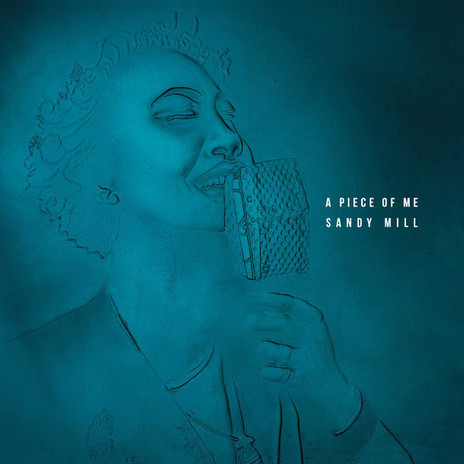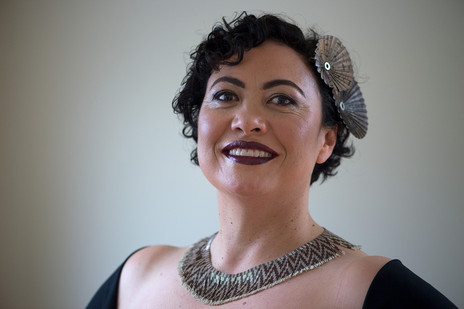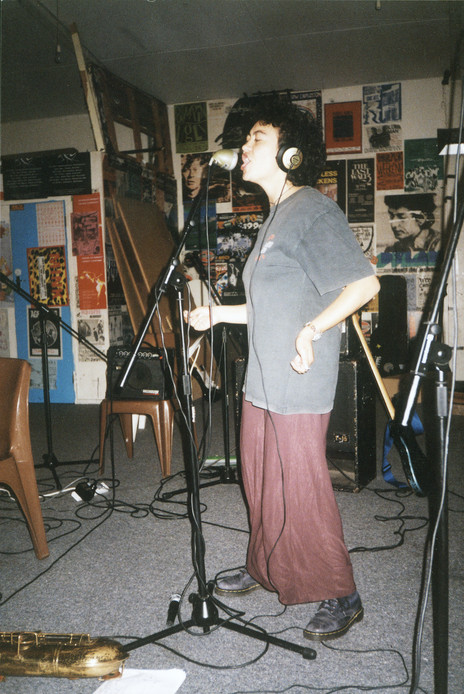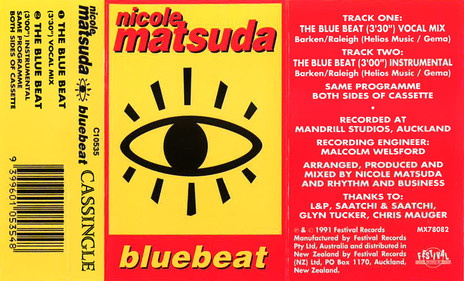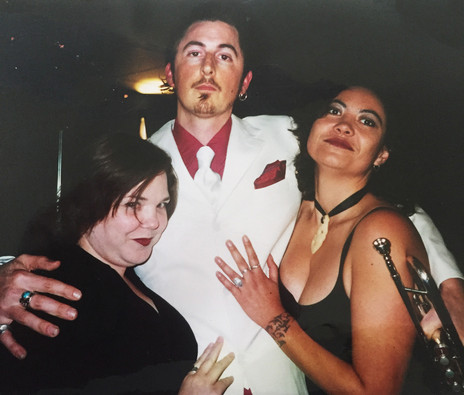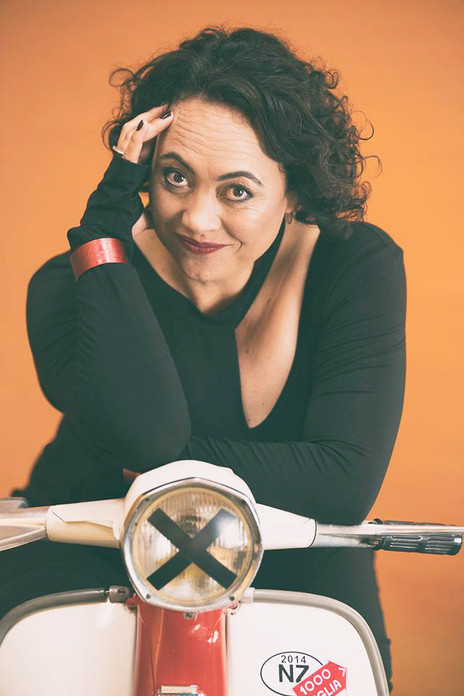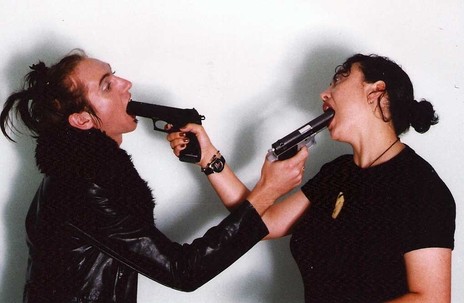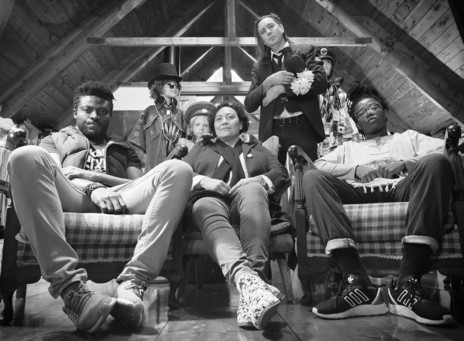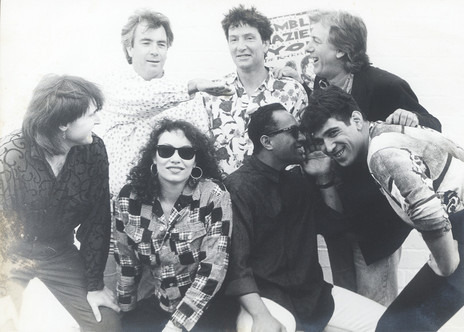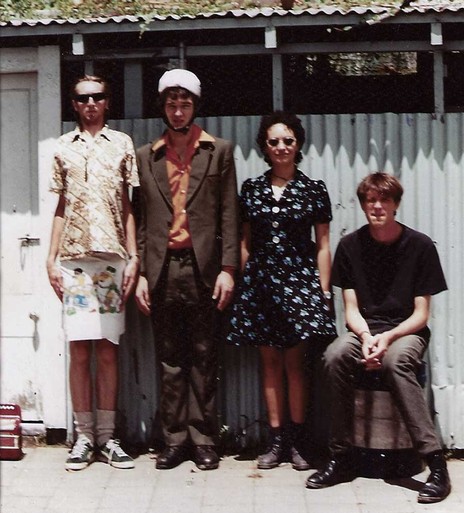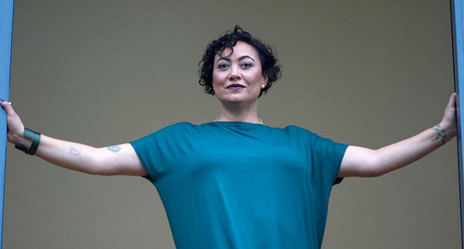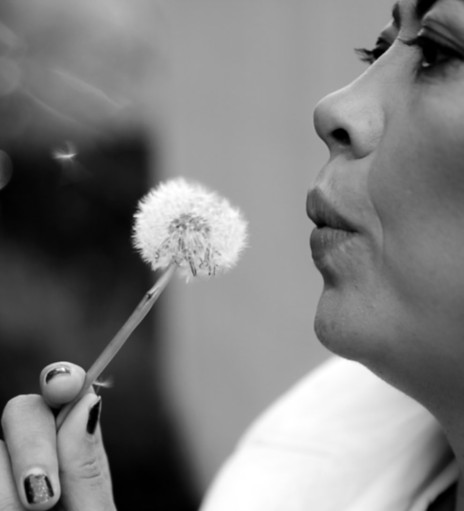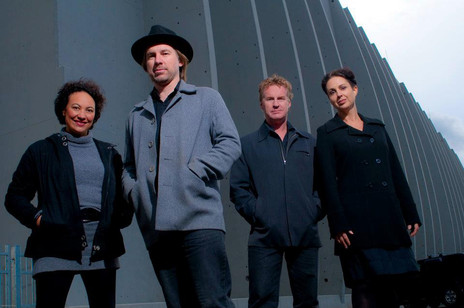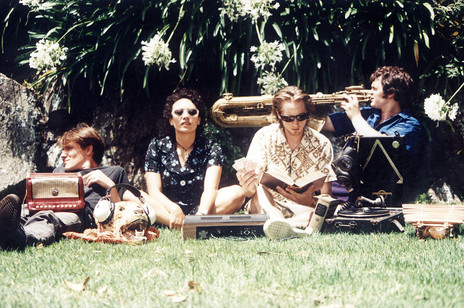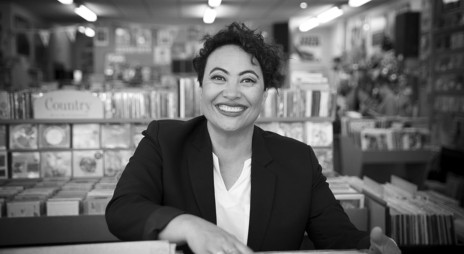Mill was born in Gisborne in 1969 and although her uncle Whare Mill (who performed and taught music in Australia) was “the only one to do much more than get the guitar out and play at a party,” there was music all around.
“I started singing quite young,” she says. “My grandparents were in the Waihirere Māori Cultural Group, so I used to get dragged along there when I was a two-year-old – and apparently I used to sing along to all the songs. That’s when I started singing. I could barely talk!”
She was six years old when she first stepped on a stage to sing.
“My grandparents used to take me along to the Gisborne Country and Western Club. They had a band and I’d sing songs there. That probably helped with my shyness a bit – because I was very shy. The first gig I ever did, aged about six, was at the Gisborne War Memorial Hall and John Hore was playing, I think Suzanne Prentice too.”
Eventually she dropped the country music (“I got to the point where I wanted to sing pop songs, so I stopped that and didn’t do anything. Just kind of forgot about it”). It wasn’t until she was 18 and living in Auckland that she got up on a stage again. Typically, it happened in the moment.
“I got up with a covers band playing at the Huapai pub. We were all dancing and they said, ‘Come up and help us with this song’ and I sang backing vocals and my friends were all ‘Hey, you’ve got a really good voice, you should think about getting some lessons’.”
She took her friends’ advice and got some tuition and by 1991 was a member of the Auckland-based band Nicole Matsuda. Their sole release, a contemporary hip-house cover of Dinah Lee’s ‘Blue Beat’ for Festival Records, features Mill on the kind of classic dance-diva refrain she would go on to provide for producers in years to come.
She was also working in two different covers bands: one along with several Māori showband veterans, including Dave Rivers, and the other formed by Tony McMaster, formerly of The Drongos.
The band was Spacesuit – the wild avant-jazz group formed by Ben Holmes, Darryn Harkness and Gabriel White.
“We’d play three gigs a week,” she says of the latter. “It was good for my chops. But I got to the point where I was going to lots of gigs as well and met Ben Holmes and he said, look, I’ve got this band and we’ve got a residency up at Luna – and I went up and they just blew my mind.”
The band was Spacesuit – the wild avant-jazz group formed by Holmes, Darryn Harkness and Gabriel White. She came along to the next rehearsal.
“All I knew about Sandy at that time was that she had sung in a covers band, says Harkness. “What struck me was her awesome personality, which was certainly reflected in her vocal ability.
“At that first rehearsal we got her playing instruments she had never picked up before. I think she found our spontaneous and experimental approach to music liberating – and of course she took to all our crazy ideas with ease and introduced an element to the group that really complemented what we were trying to do.”
“It was amazing,” Mill recalls. “I went from being the vocalist in a covers band to ‘Hey, pick that instrument up, and that one, have a go on that’. So I was able to try other things. It was really cool. And I found that I could actually play the bass and make noise on a guitar.”
She joined Spacesuit at that first rehearsal. Before long, she says, gigs with the two bands started crossing over “and I had to make a choice – and I decided I’d go with the avant-garde make-no-money band, and be creatively fulfilled.”
Spacesuit made a self-titled album in 1997 and Mill didn’t appear on record again until 2001, when she sang on Cassette’s Emo EP and, more significantly, on SJD’s Lost Soul Music. The latter would become a lasting partnership.
“I met Sean [Donnelly] up at bFM. I was doing shows up there, someone was interviewing him and I said to him ‘Hey I really love what you’re doing’. Then the next time I met him was at the Kings Arms and he was doing his solo thing with his laptop and he came up to me afterwards and said, ‘I’m looking to work with a vocalist and everyone I’ve asked has said you’.”
She also did some commercial work: “I did a New World ad that played for a long time. I was just doing a doo-doot-doo – but I’m quite good at doo-doot-doo!”
Harkness convinced her to come over to London, where there was a room spare in his Brixton squat. She played gigs around London with a UK version of Harkness’s New Telepathics – and turned heads.
“A great example of how Sandy can change a room with the power of her voice was one night after a rehearsal with New Telepathics in London when we popped into the local pub for a pint,” says Harkness.
“The pub was having a karaoke night and Sandy got up after a few people, sang a Marvin Gaye song, and the entire pub went crazy. It was beautiful to experience – everyone in the room stopped talking and was completely transfixed by the sheer power and emotion of Sandy’s performance.”
She also played shows with El Hula, the band of New Zealander Blair Jollands, who had signed to Boy George’s More Protein label.
“It was such a great band. George joined us once on stage! That was surreal.”
She sang on Subware’s ‘Into’ and recorded an incendiary vocal for Epsilon Blue’s ‘So Many Times’/‘Sweetest Sound’.
She also met a bloke she fancied: El Hula’s bass player Andrew Park. She returned to New Zealand but didn’t stay long: “I realised that I was actually terribly in love with this guy in London.”
But her brief return was significant. It established her as the voice in the local electronic music scene: she sang on Subware’s ‘Into’ and recorded an incendiary vocal for Epsilon Blue’s ‘So Many Times’/‘Sweetest Sound’. An office admin job at the scene’s nexus, the Kog Transmissions studio in Kingsland, introduced her to Pitch Black and she sang on the duo’s 2004 Ape to Angel album.
She also began a long-term musical partnership with expat British dance DJ Dick Johnson. They would go on to work together periodically until 2016, with Mill providing the vocals for successive releases on the Bristol-based NRK label.
But London called: she reunited with Park in London, then met Jasper Edwards, a Londoner who had set up the live agency Spacific – still the major hub for New Zealand dance and reggae music in the UK – after a life-changing visit to The Gathering in 1999. He introduced her to prolific psytrance producer and DJ Dick Trevor, for whom Mill became a regular session singer.
“So we started working together and I’d get these calls from other house producers. I got this call from Lofty from Chillifunk Records, and he was like, I’ve got this song, do you want to come and do something on it? It was all word of mouth. It was pretty cool!”
One session gig would often lead to another: work with dance producer Dominic Dawson led her to meet and work with Chaz Jankel, the legendary keyboard player for Ian Dury and the Blockheads.
“It was all kind of surreal. I was this Māori girl from Gisborne turning up to Chaz Jankel’s place.”
Live gigs with Park and his friend Michael Sheehy led to another opportunity. They knew Dimitri Tikovoï – producer of records by Marianne Faithfull, The Horrors, Sophie Ellis-Bextor and many others – and she became a regular session singer for him too. It’s this point where Mill admits she loses track of her discography; there were just too many sessions to keep track of.
Tikovoï brought Mill in on a project to remix Gary Numan’s ‘Cars’, for which he was doing the string arrangements. The project was headed by Flood, the English producer who had worked on albums by U2, Erasure, Smashing Pumpkins and others (“He was the most down-to-earth producer I’ve ever met,” she says).
“I’d learned a lot of that vocal sound stuff playing in Spacesuit, so it wasn’t actually that difficult for me. I loved the fact that they were asking me to do these weird things – and Dimitri knew that I’d be able to nail it. He was used to me coming in and doing takes pretty quickly.”“I had to be like a bunch of Gregorian monks and a boys’ choir. They basically put me up in the reverb room, which is where they put all the amps and stuff – I had to climb up a ladder into this concrete room – and stuck a contact mic on my throat and I just used a Shure SM57 and did all the vocals like that.
Tikovoï also worked on what is perhaps her most notable session work, even if it was “only” a backing vocal. But he wasn’t the reason she was at the studio on the day – that was down to Mill and Park getting married. Park had played in a band with Steve Hewitt, the drummer in Placebo, and Hewitt came to their wedding and the rest of the band to the wedding party.
Some time later, when they want to show off some photos of the wedding day, Placebo were in the studio, trying to finish a cover version of Kate Bush’s ‘Running Up That Hill’.
“I HAD TO BE LIKE A BUNCH OF GREGORIAN MONKS AND A BOYS’ CHOIR.”
“We were sitting around smoking spliffs and having beers and Dimitri comes out and says ‘Sandy. We need your help on this song.’ So I’m like okay, just when I’ve had a big spliff… but I went in there, and I didn’t know this till later when Andy told me, they’d been scratching their heads and were ready to drop the song because they couldn’t get it sounding right.
The single only made No.44 in the UK charts, but it has had a significant life since, appearing on the soundtracks of more than 15 films and TV shows. Even now, it’s easy enough to listen to the recording and hear how Mill’s backing vocal, composed in the moment, unlocks its purpose.“I love the song and they’d done a really beautiful dark version of it. I could hear Kate Bush’s backing vocals and thought, that’s not going to work on this. So I said ‘Okay, I’m just going to go out there and lay some ideas down, let me know what you think’. So I started and Brian Molko and the others were jumping around in the booth.”
Mill kept busy in London with live work too: squat parties, live PA appearances with Lofty and electronic duo Liquid people – and DJing. “I was working at a pub in the East End, and they had DJs and I kinda said ‘I’ll have a go!’.”
Her friend, DJ and party producer Jane Fitz, started booking her for big events (“There’d always be a soul room, and that’s where I lived”) and once she was asked to play at a wedding in Geneva where the likes of Gerard Depardieu mingled with the crowd.
In 2005, Mill and Park made New Zealand home for good. Longtime creative partnerships with Donnelly (in both SJD and The Bellbirds) and Harkness continued.
“Sandy is one of the greatest vocalists I have ever worked with,” says Harkness. “On the first New Telepathics album, which came out in 2004, Sandy came to the studio with a bunch of lyrics and just started improvising. She nailed her vocals like that – and what’s on the album is mainly her first takes. It was really quite something. Every studio session with Sandy is a joy and a lot of the time we work without too much discussion, just purely playing and experimenting.”
But Park kept urging Mill to, for the first time, do her own thing.
Finally, in 2017, she began work on her first solo project. It culminated in the five-track EP A Piece of Me. The blues and Memphis soul style of the songs surprised anyone who had Mill pegged as a dance diva, but, as the name of her label and production company She’s the Boss emphasised, she was making her own choices. Where so many of her lead vocals have been essentially refrains, songs like ‘Let It Go’ and ‘Giftbox’ are fully-developed reflections on dealing with depression and anxiety and ‘Light of Day’ is about maturing into herself as a woman.
“BRIAN MOLKO AND THE OTHERS WERE JUMPING AROUND IN THE BOOTH.”
“It’s soul, blues,” she explains. “I think it’s important to talk about that stuff. You can sing about love all you like, and I do, but there’s also just trying to get strength from being a woman in the world and doing something.”
Live performances of the new songs introduced a new collaborator on guitar and backing vocals, The Bads’ Dianne Swann. The pair have played together as everything from a duo to a six-piece band.
She is also – after a friend’s birthday party led to gigs at Golden Dawn – a DJ again, with residencies at Dr Rudi’s and Saint Alice in Auckland. She has come back to house music too, through live shows with DJ-producer Dean Webb, another old friend from London.
Already, Mill is eyeing up a new direction – “more funky, electronic stuff” – this time with a producer.
“As much as I’ve enjoyed being in control of the music, I think I need to be reined in a little bit, have someone to call me on things that maybe don’t work.”
Yet so much of Mill’s recorded work, credited and uncredited, in New Zealand and elsewhere, is a story of coming in and making it work in the time available. And whether it’s on her own account, with longtime collaborators or something completely new, it seems evident there’s much more to come.
